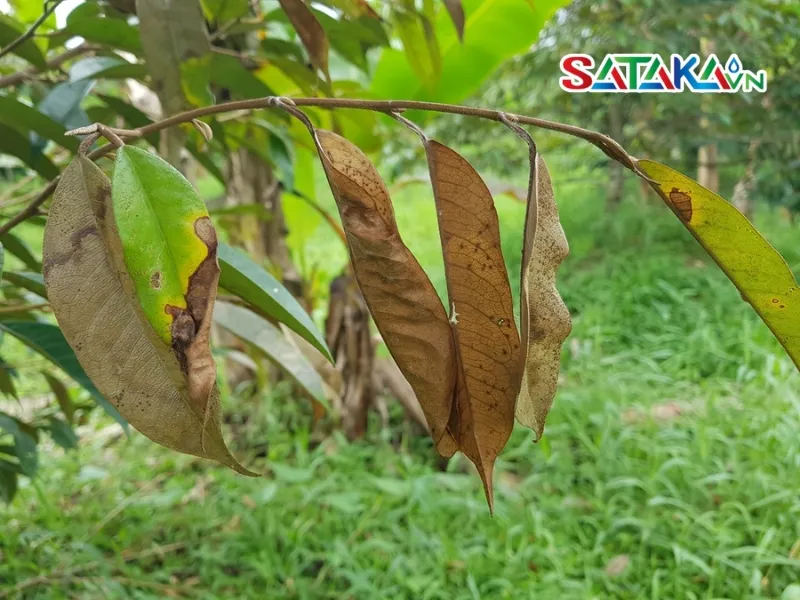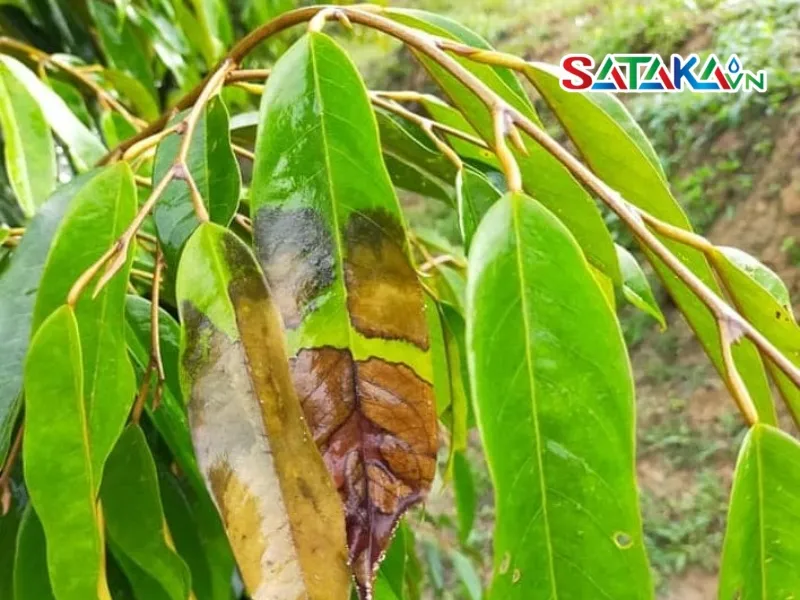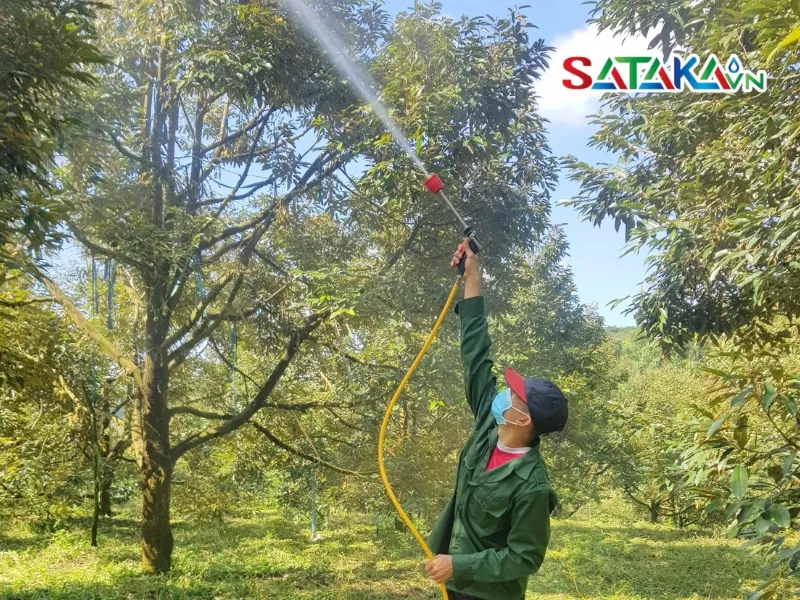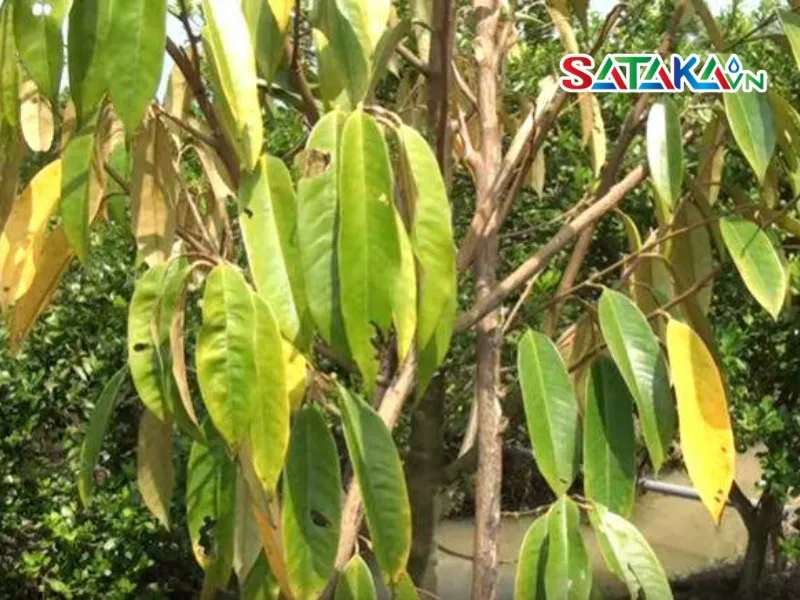Durian leaf blight is very common in trees from seedlings to mature trees. Join Sataka Vietnam to find out and come up with solutions.
Leaf blight is a significant problem affecting durian trees, leading to reduced productivity and fruit quality. The symptoms of this disease not only weaken the tree but also decrease its ability to flower and bear fruit. To help farmers effectively prevent and control leaf blight, Sataka Vietnam shares several preventive measures and effective treatment options. Let’s explore the details to protect your durian orchard from leaf blight.
Leaf blight in durian is a major threat that causes significant losses to farmers. Many might wonder about the causes of this disease, which is primarily due to the fungus Rhizoctonia solani. This fungus thrives at an ideal temperature of 28°C. Its growth slows as the temperature rises to 35°C and stops completely at 100°C.
In humid conditions, fungal hyphae and sclerotia appear on the surface of infected areas and can quickly spread to neighboring leaves. Poorly maintained orchards, high planting density, and imbalanced fertilization (excessive nitrogen and insufficient micronutrients) create ideal conditions for the disease to thrive.
Ineffective cultivation practices, such as improper pruning and failure to remove infected branches, also contribute to the development of leaf blight in durian. Additionally, dense canopies that block sunlight exacerbate the issue.

Common causes of durian leaf blight
Leaf blight in durian exhibits characteristic symptoms. If not detected and treated promptly, the disease can cause severe damage to crops.

Path to this disease outbreak on durian trees
1. Favorable environmental conditions: The growth of Rhizoctonia sp., the primary cause of leaf blight, is heavily influenced by environmental factors. High humidity and an ideal temperature of about 28°C provide the perfect environment for fungal development. The disease is particularly prevalent during the rainy season when humidity is high.
2. Poor farming techniques: Poorly maintained durian orchards, high planting density, and imbalanced fertilization (excessive nitrogen and lack of micronutrients) increase the risk of disease outbreaks. Improper pruning and failure to remove infected branches further exacerbate the problem.
3. Spread between trees: In humid conditions, fungal hyphae and sclerotia can quickly spread from infected areas to neighboring leaves. Without timely detection and treatment, the disease can spread across the entire orchard.
4. Unventilated orchards: Dense canopies that block sunlight reduce the tree's growth and create favorable conditions for fungal development and spread.
When symptoms of leaf blight appear in durian orchards, applying specialized fungicides is essential to prevent the disease from spreading. Products containing active ingredients like Azoxystrobin and Difenoconazole are known for their deep penetration and effectiveness in controlling leaf blight. Farmers should spray these fungicides regularly as per the manufacturer’s instructions for optimal results.
Pests such as green leafhoppers, whiteflies, and thrips are indirect contributors to durian diseases, especially during the growth of young shoots. To control these pests, use products containing active ingredients like Buprofezin and Emamectin Benzoate. Controlling pests helps reduce disease spread and protects the tree's health.

Current measures to prevent diseased durian trees
Maintain a clean orchard by removing fallen leaves and dry branches to minimize disease sources. Ensure proper drainage systems to avoid prolonged wet conditions that favor fungal growth.
a. When does leaf blight in durian commonly occur?
Leaf blight in durian is most common during the rainy season when humidity levels are high, creating a favorable environment for Rhizoctonia sp. to thrive and spread.
b. How can you identify a durian tree infected with leaf blight?
Symptoms include water-soaked brown spots that expand along the leaf, causing deformation, wilting, and drying. Pale yellow fungal threads may appear on infected tissues.
c. What fungicides are effective for treating leaf blight in durian?
Fungicides containing active ingredients like Azoxystrobin and Difenoconazole are effective for deep penetration and control of leaf blight.
d. How can you prevent sucking pests from harming durian trees?
To prevent pests like green leafhoppers, whiteflies, and thrips, use products containing active ingredients like Buprofezin and Emamectin Benzoate. Controlling these pests reduces disease spread and ensures tree health.
e. What cultivation measures help prevent leaf blight in durian?

Preventing and controlling leaf blight in durian is vital for maintaining healthy orchards and achieving high yields. Sataka offers a wide range of high-quality disease control products, including treatments for bacteria, fungi, and viruses. Visit our Disease Control Product category for more information or contact us for detailed advice and support.